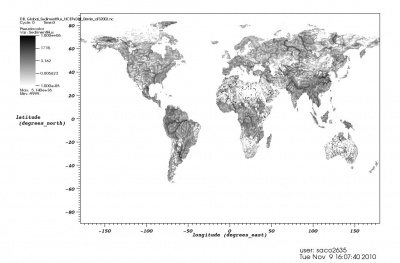HPCCprojects:The BQARTwbm distributed sediment flux model: Difference between revisions
No edit summary |
No edit summary |
||
| Line 1: | Line 1: | ||
<!-- | |||
How to create a new "HPCCproject" page: | How to create a new "HPCCproject" page: | ||
1) Log in to the wiki | 1) Log in to the wiki | ||
| Line 71: | Line 71: | ||
==Funding== | ==Funding== | ||
This research is funded by NASA, through the Interdisciplinary Research in Earth Science Program, NNH062DA001N-IDS | This research is funded by NASA, through the Interdisciplinary Research in Earth Science Program, NNH062DA001N-IDS | ||
|[[Image:NASA_Logo.jpg|75px|]] | |||
==Publications and presentations== | ==Publications and presentations== | ||
Revision as of 17:21, 10 December 2010
The BQARTwbm distributed sediment flux model
Project description

The Framework for Aquatic Modeling of Earth System (FrAMES) is a spatially and temporally explicit multi-scale (local through global) hydrological/biogeochemical modeling scheme. It is an ongoing interdisciplinary project allowing predictions of changing material flux from major continental rivers in response to changing environmental conditions.
In this project we develop and test a new component within this framework, a spatially explicit sediment flux model. We expend the BQART sediment flux model from point (river outlet) to distributed (pixel) scale by integrating it into the WBMplus continental hydrology model. BQART is an analytical model describing the empirical relationship between basin geomorphic (area and relief), climatic (temperature and precipitation), geologic (lithology and ice cover) and human (reservoir and soil erosion) characteristics and short and long-term sediment flux (implemented in the HydroTrend model). WBMplus is a spatially explicit model describing varying components of global hydrological cycle.
The integrated model (BQARTwbm) allow daily predictions of global scale sediment fluxes at a spatial resolution of 30 and 6 minute.
Most of the new code development and testing was done on the CSDMS HPCC.
- The main advantages of using the CSDMS HPCC in this project are:
- Allow multiple threads of long-term simulations;
- Storage of the very large input and output datasets needed (100's GB);
- Usage of multiple code development, compilation and visualization tools (e.g. VisIt);
- Allow easy cooperation with other members of the FrAMES project;
Objectives
- Development and testing of the BQARTwbm model as part of the FrAMES project;
- Model Validation;
- Continued development of the model toward a more physically-based implementation;
- Adding grain-size distribution component.
Time-line
| Start date: | July 2010 |
| BQARTwbm initial development (finished): | Oct 2010 |
| Model testing: | Nov 2010 |
| Model validation: | Dec 2010 |
| Continued model development and applications (currently until): | July 2012 |
Models in use
The BQARTwbm model incorporate the river-outlet sediment flux model BQART (implemented in the HydroTrend model) in the WBMplus distributed global water-balance model.
Results
To date (Nov 2010) we produced a working sediment flux module for the FrAMES framework (the BQARTwbm model) which we are currently testing and will be validating soon.
Users
- Sagy Cohen
- Albert Kettner
- James Syvitski
- Balazs Fekete (WBMplus developer)
Funding
This research is funded by NASA, through the Interdisciplinary Research in Earth Science Program, NNH062DA001N-IDS
Publications and presentations
Conferences
- Cohen, S., Kettner, A.J., Syvitski P.M.J. October 2010. Modeling global scale sediment flux, a new component in the spatially distributedFramework for Aquatic Modeling of Earth System (FrAMES), Modeling for Environmental change, San Antonio, Texas. Poster
- Cohen, S., Kettner, A.J., Syvitski P.M.J. December 2010. Modeling global scale sediment flux, a new component in the spatially distributed Framework for Aquatic Modeling of Earth System (FrAMES), AGU fall meeting, San Francisco, USA (Session: H44C. Predicting Behavior of Freshwater Systems in a Changing Environment III).
Links
This would be the place to provide links that are related to your project.

